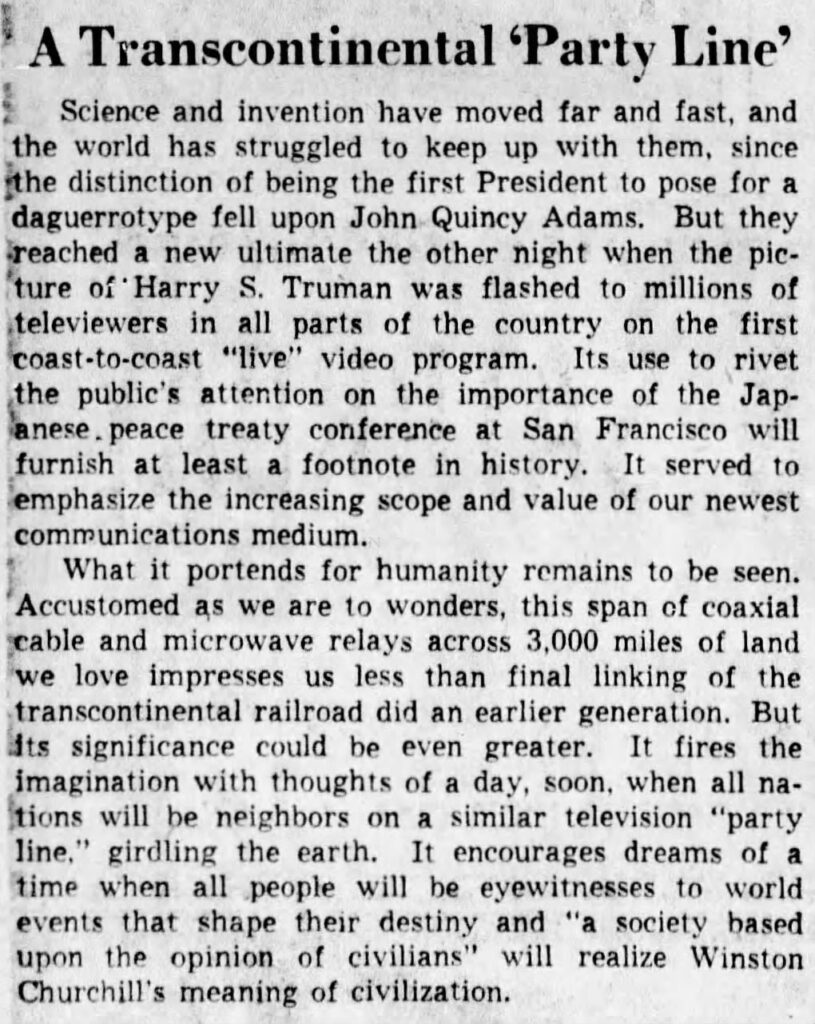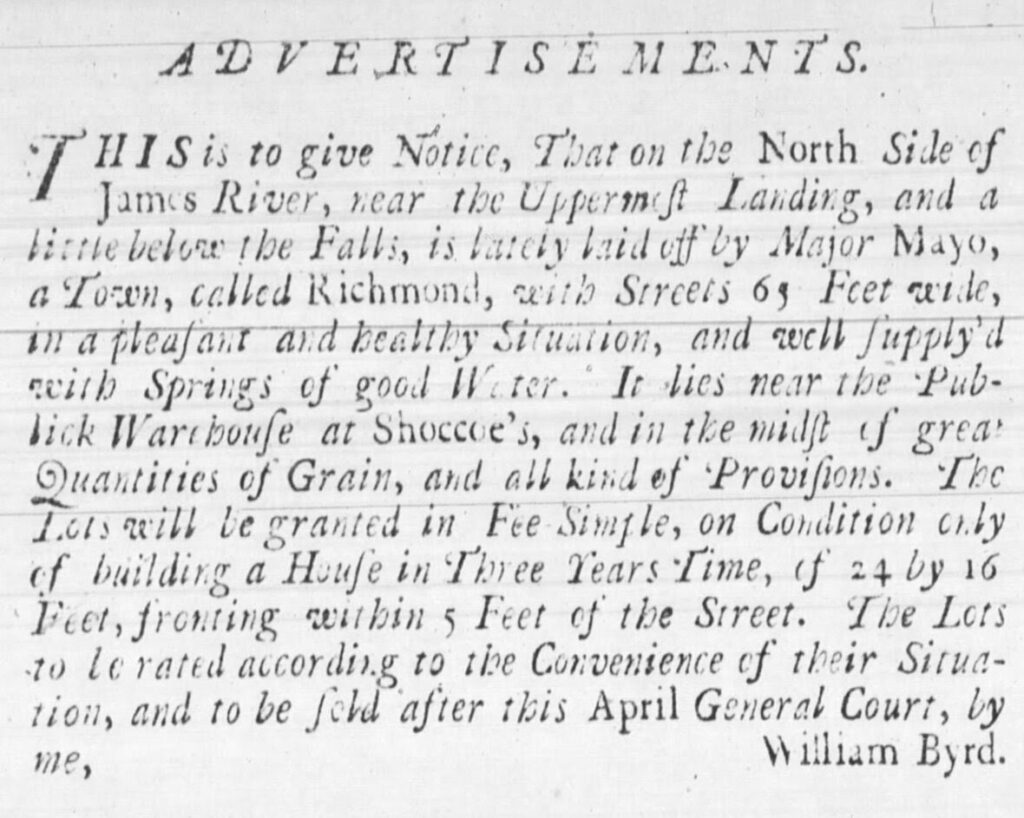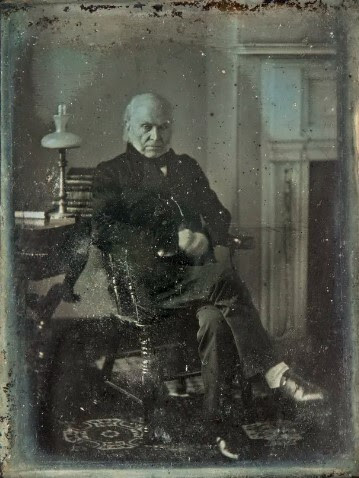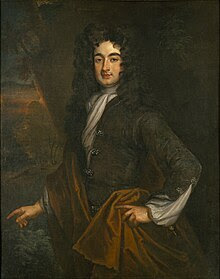
27 Jul Ancestor- Newsletter- July 27, 2024
Contents
- 1 THE QUAKER ANTI-SLAVERY MIGRATION FROM THE SOUTHEAST TO THE NORTHWEST
- 2 SMITHSONIAN ACQUIRES 1846 DOLLEY MADISON DAGUERREOTYPE FOR $456,000
- 3 EATING LUNCH WHERE THE SECRET DISCUSSIONS FOR ENDING WORLD WAR II OCCURED
- 4 ANCESTOR- THE FORD V-8, CLYDE BARROW AND JOHN DILLINGER
- 5 DANCESTORS VISITED WILLIAM BYRD’S WESTOVER PLANTATION
- 6 WHAT ABOUT YOUR DESCENDANTS KNOWING ABOUT YOUR ANCESTORS?
 THE QUAKER ANTI-SLAVERY MIGRATION FROM THE SOUTHEAST TO THE NORTHWEST
THE QUAKER ANTI-SLAVERY MIGRATION FROM THE SOUTHEAST TO THE NORTHWEST
John Woolman (1720-1772) was an American merchant, tailor, journalist, Quaker preacher, and early abolitionist during the colonial era. Based in Mount Holly, near Philadelphia, he traveled through the American frontier to preach Quaker beliefs and advocate against slavery and the slave trade, cruelty to animals, economic injustices and oppression, and conscription.
Beginning in 1755, with the outbreak of the French and Indian War, Woolman urged tax resistance to deny support to the colonial military. In 1772, Woolman traveled to England, where he encouraged Quakers to support the abolition of slavery.
Woolman published numerous essays, especially against slavery. Notice the familiar name of the printer of the book pictured above.
He kept a journal throughout his life, published posthumously, entitled The Journal of John Woolman (1774). It is considered a prominent American spiritual work and has been included in Volume I of the Harvard Classics since 1909.
Following Woolman, one of the most well-known Quaker abolitionists was my wife’s ancestor her 5th Great Grandfather, Zachariah Dicks.
In 1754, Zachariah joined the Quaker Meeting at Warrington, York Co., Pennsylvania. In 1755, he moved to the Cane Creek Quaker settlement in North Carolina, where he married and started a family.
He was a fervent Quaker minister. He visited Europe between 1784 and 1787. He visited the Bush River, South Carolina, meeting many times between 1800 and 1804.
He was known as a prophet and forewarned the Quakers of South Carolina that if they did not abandon slavery, the fate of Santo Domingo (slavery uprising and massacre) would soon be theirs. He warned Quakers in the South of a terrible internecine war that would descend upon America because of the immoral scourge of slavery. He predicted that the war would be in the lifetime of their children. And so, it was ~ The Civil War.
In 1803, at the Bush River Monthly Meeting, Zachariah Dix delivered a memorable sermon:
O Bush River! Purge thyself. Young men, young women, to you I appeal. The great northwest territory lies over the mountains beyond the Ohio River. It is a wild forest. It is a wilderness. From the wigwams of the savage the smoke still ascends through the boughs of the trees, but it is a fertile land. It is a land forever dedicated to human freedom. There you can make productive fields. There you can make friends with the Red Man. To you I appeal, flee to that land. Ancestor.
Shake the dust of human bondage from your feet for your own sake and for the sake of your children’s children. This system of human slavery will fall. The cup of its iniquity is well-nigh filled. Go to the Northwest Territory! Look not behind you into this Sodom of human slavery, for the fires of Heaven shall descend upon it and the wrath of the Almighty shall consume it. O Bush River, thy beauty has faded away! Thy light has gone out, and in a few years this Meeting house shall be naught but the home of the bats and the owls.
Responding to this divinely inspired message, Bush River Friends moved to the Little Miami River lands as an entire body. Many families left well-established farms for unexplored tracts of land in the Ohio wilderness.
He purportedly persuaded the North Carolina Quakers to sell their land for a fraction of its value and move to Ohio and Indiana. Zechariah traveled as far south as Wrightsboro, Georgia, with his message. Between 1800 and 1809, thousands of Quakers migrated from Virginia, North and South Carolina, and Georgia into the Northwest Territory (OH, IN, IL), until almost none remained.

 SMITHSONIAN ACQUIRES 1846 DOLLEY MADISON DAGUERREOTYPE FOR $456,000
SMITHSONIAN ACQUIRES 1846 DOLLEY MADISON DAGUERREOTYPE FOR $456,000
Dancestors previously shared Dolley’s portrait and story in our June 15, 2024, June 1, 2024, and another 1848/1849 picture of her on October 22, 2022 (links below).
Three years before she died in 1849 at age 81, Dolley Madison posed for photographer John Plumbe Jr. at his studio in Washington, D.C. Clad in a crocheted shawl and one of her famous turbans, carefully arranged to cover most of her dark curls, the former first lady met the camera’s gaze with a piercing yet inviting stare.
The surviving daguerreotype from this 1846 sitting recently resurfaced after decades of obscurity and is now identified as the earliest known photograph of an American first lady; the portrait went up for auction last week at Sotheby’s, where it fetched more than six times its estimated value of $50,000 to $70,000. The Smithsonian’s National Portrait Gallery paid $456,000 for the daguerreotype, which will reside in the museum’s permanent collection alongside the earliest known photograph of a United States president: an 1843 portrait of John Quincy Adams, acquired at auction for $360,500 in 2017 (see above).
6/15/2024
https://gem.godaddy.com/p/ca03d91
6/1/2024
https://gem.godaddy.com/p/6154a91
10/22/2022
https://gem.godaddy.com/s/5810e41

 EATING LUNCH WHERE THE SECRET DISCUSSIONS FOR ENDING WORLD WAR II OCCURED
EATING LUNCH WHERE THE SECRET DISCUSSIONS FOR ENDING WORLD WAR II OCCURED
Dancesrors enjoyed lunch at the Grand Café Al Porto in Lugano, Switzerland. Not knowing there was tremendous history in the room when we walked in for a meal. Here’s the edited story from their website:
On March 3, 1945, in the “Cenacolo” room on the first floor, in the rooms of the then Bianchi Restaurant, now the Grand Café Al Porto, the very first secret meeting between German officers and Allied representatives took place at the height of the greatest tragedy that Europe remembers. During this meeting, the repentance that dissuaded the German leaders from implementing the “scorched earth” strategy in Northern Italy matured.
Operation Sunrise, Operation Sunrise, carried out by a Swiss officer, Major Max Waibel (pictured above), then in the Swiss Army Intelligence Service, contacted by the Italian nobleman Baron Luigi Parrilli, provided valid and decisive help in creating the important premises that led to the capitulation signed in Caserta on April 29, 1945. With that signature and with the unconditional capitulation of the German army, a very bloody war finally ended, sparing Northern Italy not only countless deaths but also the severe destruction that the order to declare a “scorched earth” would have caused. Ancestor.
We read in “The Surrender of the Eight Hundred Thousand” in this regard:
“…In the meantime, we prepared for the midday meal. The owner of the Bianchi restaurant, Alberto Bianchi, despite the restrictions imposed by rationing, worked wonders. He had no suspicion whatsoever that he was giving shelter to conspirators, that he was hosting a conference of world interest, of historical importance. With the intuition of hoteliers extraordinarily sharpened in Swiss hoteliers, he had however understood that he was dealing with important people.”

 ANCESTOR- THE FORD V-8, CLYDE BARROW AND JOHN DILLINGER
ANCESTOR- THE FORD V-8, CLYDE BARROW AND JOHN DILLINGER
America’s first affordable V8-powered car was introduced in 1932 by the Ford Motor Company, which quickly grew tremendously popular and received effusive praise from motorists. Among those enthusiastic drivers was Texas resident Clyde Barrow, who, along with his female companion, Bonnie Parker, embarked that year on an infamous crime spree that would firmly establish the pair as American legends.
From 1932 to 1934, during which Bonnie and Clyde engaged in a string of robberies in Texas and surrounding states, Clyde Barrow repeatedly stole Ford V8 automobiles at every opportunity, as the vehicles’ powerful engines, combined with Clyde’s excellent driving skills, enabled the Barrow Gang to evade the pursuit of lawmen throughout the Midwest continually.
Such was Clyde Barrow’s appreciation for the Ford V8 that he supposedly penned and mailed the laudatory letter above to company founder Henry Ford in April 1934.
The letter bore a postmark indicating it was mailed from Tulsa, Oklahoma, on April 10, 1934. Henry Ford received it on April 13, 1934, at his office in downtown Detroit. Assuming the letter was real, Ford had his secretary draft a ‘thank you’ reply, which was sent to Clyde care of General Delivery in Tulsa (although he never received it, as the Barrow Gang had headed out of Tulsa by then).
Seventy-five years later, the question remains: Was this letter (which is displayed at the Henry Ford Museum) written by Clyde Barrow? Some skeptics have pointed out that its handwriting appears to be a much closer match to Bonnie Parker’s than to Clyde’s. Still, biographer Jeff Guinn notes that its contents (and the circumstances of its mailing) put its authenticity within the realm of possibility:
The letter sounds like Clyde — writing a fan letter to Henry Ford would have appealed to his sense of humor. The spelling and grammatical errors are appropriate to Clyde’s limited education, and the date of the mailing and the Tulsa postmark jibe with where Clyde was at the time. But after Ford made the letter public, Clyde’s family swore it wasn’t authentic because of its signature — “Clyde Champion Barrow.” (Clyde Barrow’s middle name was Chestnut. He impishly listed “Champion” as his middle name when he entered the Texas state prison at Huntsville in 1930.) Ancestor.
Also in early April 1934, a letter purporting to be from Clyde Barrow was sent to Amon Carter, the publisher-editor of the Fort Worth Star-Telegram, complaining about how that newspaper depicted Bonnie Parker in their coverage of the Barrow Gang’s exploits. An endnote in Guinn’s biography of Bonnie and Clyde indicates that he (as well as Clyde’s sister) doubted the authenticity of both letters:
Marrie Barrow Scoma vehemently denied that her brother had written the letters in print and conversation. While it’s fun to think they were, Marie was almost undoubtedly right. Clyde wouldn’t have signed a bogus middle name to the Ford letter, and the Carter letter was mailed from the small North Texas hamlet of Decatur on a date when the Barrow Gang had fled the state for Oklahoma. Still, many historians have accepted them as Clyde’s handiwork. No one will ever know for sure.
One month after the mailing of the reputed Clyde Barrow letter to Henry Ford, a quirky repetition occurred when the Ford Motor Company announced it had received the following letter, dated May 26, 1934, and postmarked from Detroit:
Hello Old Pal. Arrived here at 10:00 AM today. Would like to drop in and see you. You have a wonderful car. Been driving it for weeks. It’s a treat to drive one. Your slogan should be, drive a Ford and watch the other cars fall behind you. I can make any other car take a Ford’s dust!
Bye-bye, John Dillinger
Unlike the Barrow letter, this latter missive was conclusively demonstrated to be a forgery compared with earlier samples of Dillinger’s handwriting.
 DANCESTORS VISITED WILLIAM BYRD’S WESTOVER PLANTATION
DANCESTORS VISITED WILLIAM BYRD’S WESTOVER PLANTATION
William Byrd II was born in 1674 at Westover Plantation in Charles City County, Virginia, his father having emigrated from England and become an Indian trader and slave importer. Byrd was sent to England to be schooled and study law but returned to Westover on his father’s death in 1705 to run the, by then, large and prosperous estate.
Byrd married Lucy Parke, the daughter of Colonel Daniel Parke II, a wealthy landowner and governor of the Leeward Islands, which increased his regional wealth and power. In 1709, he was made a King’s Councilor, an appointment he held for the rest of his life.
Although Byrd fought with his wife almost daily, they also loved each other passionately. But she died young, in 1715, from smallpox. That same year, he returned to England, where he stayed until 1726. After marrying again (Maria Taylor), he settled into his role as head of the plantation and part of the ruling clique. He built a large house at Westover, helped found the city of Richmond, and collected the most extensive library in the colonies. He died in 1744.
However, Byrd is mainly remembered for his talent as a writer. The History of the Dividing Line Betwixt Virginia and North Carolina, an account by Byrd of surveying the border between the US states of North Carolina and Virginia in 1728, is considered one of the earliest colonial literary works and a minor humorous masterpiece.
Byrd was also a letter writer and diarist of some note, though some of his diaries written in shorthand were not decoded or published until the 20th century. Dietz Press published The Secret Diary of William Byrd of Westover, 1709-1712, in 1941, and Another Secret Diary of William Byrd of Westover, 1739-1741, the following year. Nearly 20 years later, Oxford University Press published The London Diary, 1717-1721, and other writings.
Several websites have substantial extracts from Byrd’s diaries, including the National Humanities Center and student resource pages at the University of Maryland. Here are some excerpts:
September 19, 1709. I rose at 4 o’clock and read a chapter in Hebrew and some Greek in Josephus. I said my prayers and ate milk for breakfast. I danced my dance. I beat Anaka for letting the child piss in bed. I wrote a letter to England for the government of Maryland. I read some law. I ate blue wing for dinner. In the afternoon I wrote another letter to England and then took a walk about the plantation. My wife was something better, thank God. I said my prayers and had good health, good thoughts,and good humor, thanks be to God Almighty. I read some Greek in Homer.
October 6, 1709. I rose at 6 o’clock and said my prayers and ate milk for breakfast. Then I proceeded to Williamsburg, where I found all well. I went to the capitol where I sent for the wench to clean my room and when I came I kissed her and felt her, for which God forgive me. Then I went to see the President, whom I found indisposed in his ears. I dined with him on beef on beef [sic]. Then we went to his house and played at piquet where Mr. Clayton came to us. We had much to do to get a bottle of French wine. About 10 o’clock I went to my lodgings. I had good health but wicked thoughts, God forgive me.
November 2, 1709. I rose at 6 o’clock and read a chapter in Hebrew and some Greek in Lucian. I said my prayers and ate milk for breakfast, and settled some accounts, and then went to court where we made an end of the business. We went to dinner about 4 o’clock and I ate boiled beef again. In the evening I went to Dr. [Barret’s] where my wife came this afternoon.
Here I found Mrs. Chiswelt, my sister Custis, and other ladies. We sat and talked till about n o’clock and then retired to our chambers. I played at [r-m] with Mrs. Chiswell and kissed her on the bed till she was angry and my wife also was uneasy about it, and cried as soon as the company was gone. I neglected to say my prayers, which I should not have done, because I ought to beg pardon for the lust I had for another man’s wife. However I had good health, good thoughts, and good humor, thanks be to God Almighty.
December 3, 1709. I rose at 5 o’clock and read two chapters in Hebrew and some Greek in Cassius. I said my prayers and ate milk for breakfast. I danced my dance. Eugene pissed abed again for which I made him drink a pint of piss. I settled some accounts and read some news. About 12 o’clock I went to court where I found little good company. However I persuaded Mr. Anderson and Colonel Eppes to come and dine with me. I ate a venison pasty for dinner. Ancestor.
In the evening Mr. Anderson and I walked to Mr. Harrison’s where we found Frank W-l-s and James Burwell and Isham Randolph. Here I ate custard and was merry. I stayed till 9 o’clock and when I came home my wife was in bed. I neglected to say my prayers and had good health, good thoughts, and good humor; thanks be to God Almighty.

 WHAT ABOUT YOUR DESCENDANTS KNOWING ABOUT YOUR ANCESTORS?
WHAT ABOUT YOUR DESCENDANTS KNOWING ABOUT YOUR ANCESTORS?
Reach out to Dancestors Genealogy. Our genealogists will research, discover, and preserve your family history. No one is getting any younger, and stories disappear from memory every year and eventually from our potential ability to find them.
Preserve your legacy, and the heritage of your ancestors.
Paper gets thrown in the trash; books survive!
So please do not hesitate and call me @ 214-914-3598 and get your project started!
Visit our website to learn more!


 THE QUAKER ANTI-SLAVERY MIGRATION FROM THE SOUTHEAST TO THE NORTHWEST
THE QUAKER ANTI-SLAVERY MIGRATION FROM THE SOUTHEAST TO THE NORTHWEST SMITHSONIAN ACQUIRES 1846 DOLLEY MADISON DAGUERREOTYPE FOR $456,000
SMITHSONIAN ACQUIRES 1846 DOLLEY MADISON DAGUERREOTYPE FOR $456,000 EATING LUNCH WHERE THE SECRET DISCUSSIONS FOR ENDING WORLD WAR II OCCURED
EATING LUNCH WHERE THE SECRET DISCUSSIONS FOR ENDING WORLD WAR II OCCURED ANCESTOR- THE FORD V-8, CLYDE BARROW AND JOHN DILLINGER
ANCESTOR- THE FORD V-8, CLYDE BARROW AND JOHN DILLINGER DANCESTORS VISITED WILLIAM BYRD’S WESTOVER PLANTATION
DANCESTORS VISITED WILLIAM BYRD’S WESTOVER PLANTATION WHAT ABOUT YOUR DESCENDANTS KNOWING ABOUT YOUR ANCESTORS?
WHAT ABOUT YOUR DESCENDANTS KNOWING ABOUT YOUR ANCESTORS?